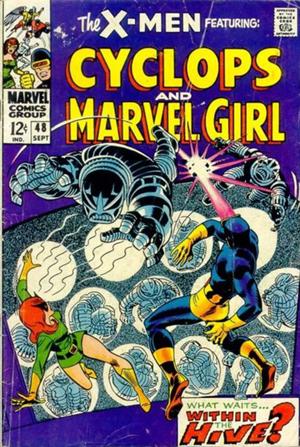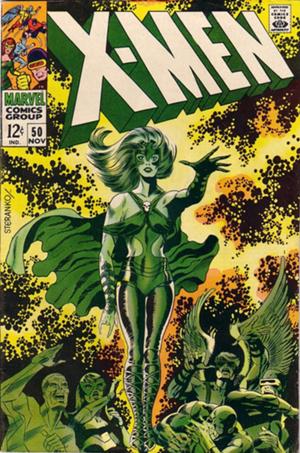The X-Men of the 1980s and beyond will be known for its strong female characters (in both the Beatonesque and non-Beatonesque senses of the term). X-Men is not at that stage yet. Our regular female characters are Jean, who is still a cipher, and the even more loosely defined Zelda, Candy and Vera. None of the random mutants they have fought or tried to recruit have been women, apart from Wanda, and she's rather subservient to Pietro (and has even been depowered). Jean has had to juggle the roles of love interest, nursemaid, temporary cook, and uniform designer along with her position in the team. It is, to coin a phrase, a bit of a sausage-fest.
That starts to change now. This story introduces Lorna Dane, later to be known as Polaris. Lorna is a "latent mutant" (as we can see from her poorly dyed green hair 1), and is the target of Mesmero's plan. Her mutation is forcibly activated, and she takes her place as "M-II", Magneto's daughter. While she is not exactly free from being a love interest (Bobby has a crush on her), it is her moral choice to stand aside from Magneto, and break free of Mesmero's control that provides the resolution to the plot. Jean also gets to use her telepathy well (this is the first use of it as an intercom, I believe), and has a good moment when she tells the boys to stop arguing. Hardly radical, but we're looking for crumbs here. It still doesn't pass the Bechdel test 2, but it's conceivable that it could.
I am told that the Magneto here isn't really Magneto, but instead Xorna robot pretending to be Magneto, but there doesn't seem to be any indication of that in the text. If we assume that he's a robot created by Mesmero, or at least deployed with Mesmero's knowledge, then the scenes where Scott (as Erik the Red) installs himself as Magneto's lieutenant, has a deeper meaning, as Mesmero is hoist with his own petard.
As to Lorna's paternity - Mesmero claims she is the "daughter of Magneto". She accepts this immediately - possibly because of Mesmero's powers. Bobby arrives on the the antepenultimate page bearing information: Lorna was adopted after her biological parents died in a plane crash.3 Her father's sister and her husband raised her instead. This apparently explains why she felt alienated from her father - who is not a blood relative of hers at all. Magneto found out about her powers somehow (despite the fact she only developed them due to being put in the machine in #50), and concocted the story based on that. I'm not sure this makes any sense, but it doesn't need to be true, it only needs a certain plausibility...
I don't talk about art much. This is partly because I don't feel I'm qualified to talk about it, and partly because I'm using the black and white Essential Marvel collections, but also because there's not been much to say. Werner Roth and Don Heck have been competent in following in Kirby's footsteps. Flicking back through the volume, I see a creeping sophistication in layouts and in panels. The middle two issues of this arc, pencilled by Jim Steranko, are something else entirely. Steranko designs a new, 3D, logo for issue #50, which will remain in use until #394, and places it atop a scene that prefigures the rise of Phoenix in #101. Compare the covers of #48 and #50.
You'd scarcely credit that they were released only two months apart. But it's not just the cover. The opening page of #50 is a series of point-of-view panels unprecedented so far. The art exhibits the first signs of decompression. The dialogue, on the other hand, is still classic silver age verbosity.
The X-Men may be flagging commercially, but creatively it's doing very well, and is anticipating many of the features of the classic 1970s run.
1. You'd think you'd use something more permanent if you were trying to hide your inhuman naturally green hair.
2. I see the Bechdel test as best applied to bodies of works rather than to individual items. It seems likely that no issue of X-Men I've covered yet has passed that.
3. Lots of orphans in Marvel. Curious number of them from plane crashes (Cyclops & Havok, Spider-Man, and now Polaris).



For what it's worth, later(non X-Men) stories will reveal that the Magneto robot was created by Captain America villain Machinesmith, for reasons that are never made terribly clear.
ReplyDeleteI'd heard that, but also I hear they never outright state that this is the same Magneto robot as is made there.
ReplyDeleteWhen I write X-Men I am totally resolving this plot line.
Actually, I've blown my chances of ever writing X-Men by doing this blog, haven't I. Curses!
Ha! Sometimes I think the same thing...
ReplyDeleteI'll have to see!
DeleteI've put "make an indie comic" on my TODO list for 2013, at least. I plan to try and find an artist in Leeds at the weekend.
By the way, do you know that the conclusion to this storyline was ret-conned into being true after all (by guess who?) Actually the "latent mutant" and even the green hair have been recently retconned too.
ReplyDelete